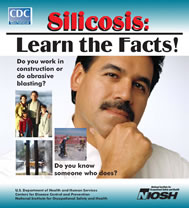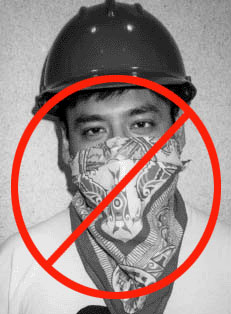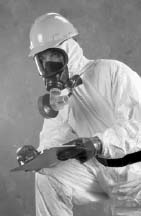
 |
|||
|
NIOSH Publication No. 2004-108:Silicosis: Learn the Facts! |
August 2004 |
|
| This document presents information in an easy to read format describing silica exposures, the effects of silicosis, and methods to protect against silicosis. Contents
| 
|
||||||
ORDERING INFORMATIONTo receive documents or more information about occupational safety and health topics, contact NIOSH at: NIOSH -- Publications Dissemination Telephone: 1-800-35-NIOSH (1-800-356-4674) Fax: 513-533-8573 E-mail: Pubstaft@cdc.gov or visit the NIOSH Web site at www.cdc.gov/niosh DHHS (NIOSH) Publication No. 2004-108 August 2004 |
Acknowledgements
NIOSH wishes to thank the International Union of Painters and Allied Trades and the Laborers' International Union of North America, who provided significant and valuable assistance with this document. We also thank the New Jersey Department of Health and Senior Services for providing photographs and the Occupational Safety and Health Administration (OSHA) for providing technical assistance.
The principal contributors to this brochure were Charles E. Williams, III, Dorothy Tan-Wilhelm, Rene D. Massengale, Crystal Ellison, Catherine Inman, Marieli Moreta-Medero, and Laine Hall. We would also like to recognize Don Eggerth, Chris Hawkins, Nancy Bollinger, Jennifer Welbourne, Tanya Headley, Sybil Buzzard Ott, Steve Booth-Butterfield, and Laura Blanciforti for their contributions and technical assistance. The document reviewers include Robert Castellan, Paul Hewett, Kenneth Linch, Lee Petsonk, Susan Feldmann, Faye Rice, Hector Ortega, Janie Gittleman, Stew Burkhammer, and Bill Perry. We extend a special thanks to Brian Day, Ken Linch, Joe Cocalis, William Eschenbacker, Robert Stein, Roland Berry Ann, Hector Ortega, John Parker, and Jesus Deleon for providing photographs and technical assistance. Kimberly Clough Thomas provided the cover design, layout, and photographs for the document.
Safety Information
For more information on silicosis and how it can affect you and your family, visit our Web site at:
http://www.cdc.gov/niosh/topics/silica
For more information or for answers to questions about any safety and health regulatory matters, contact the Occupational Safety and Health Administration (OSHA)
U.S. Department of Labor
Occupational Safety & Health Administration
200 Constitution Avenue
Washington, D.C. 202101-800-321-OSHA (6742)
(Spanish speaking staff available)Silicosis: Learn the Facts!
Do you work in construction or do abrasive blasting?
If so, here are some important facts you need to know:
- Since 1968, more than 14,000 workers in the U.S. have died from a disease called silicosis.
- In the U.S. each year more than 200 workers die with this disease while hundreds more become disabled.
- Many workers with silicosis are only in their thirties; some are as young as 22 years old. Many of them are unable to take care of themselves and their families.
What is silicosis and how can you avoid or prevent it?
This booklet will give you information about silicosis, what causes it, the symptoms, and the ways you can avoid developing the disease.
| WARNING! |
|---|
Silicosis IS NOT CURABLE, but it IS PREVENTABLE. Learn the facts and
know how to protect yourself. Silicosis affects both your health AND the
welfare of your family. |
Description of Silicosis
Silicosis is a disabling and often fatal lung disease caused by breathing dust that has very small pieces of crystalline silica in it. Crystalline silica is found in concrete, masonry, sandstone, rock, paint, and other abrasives. The cutting, breaking, crushing, drilling, grinding, or abrasive blasting of these materials may produce fine silica dust. It can also be in soil, mortar, plaster, and shingles. The very small pieces of silica dust get in the air that you breathe and become trapped in your lungs. Even the very small pieces of dust that you cannot see will harm you. As the dust builds up in your lungs, the lungs are damaged and it becomes harder to breathe.
Are YOU breathing silica dust?
If YOU do one of the following jobs, you ARE at risk for breathing silica dust:
- Removal of paint and rust with powertools;
- Abrasive blasting of bridges, pipes, tanks, and other painted surfaces especially while using silica sand;
- Grinding mortar;
Abrasive blasting of concrete (many bridges and buildings are made of concrete);
- Crushing, loading, hauling, chipping, hammering, drilling, and dumping of rock or concrete;
- Chipping, hammering, drilling, sawing, and grinding concrete or masonry;
- Demolition of concrete and masonry structures;
Dry sweeping or pressurized air-blowing of concrete or dust; or
- Jackhammering on various materials.
| ATTENTION! |
|---|
When you wear dusty clothing at
home or in your car, you may be carrying silica dust that your family
will breathe. |
Who is at Risk?
Workers in the following occupations are at risk for developing silicosis:
- Highway and bridge construction and repair
- Building construction, demolition, and repair
- Abrasive blasting
- Masonry work
- Concrete finishing
- Drywall finishing
- Rock drilling
- Mining
- Sand and gravel screening
- Rock crushing (for road base)
| |
||
|---|---|---|
ATTENTION! Types of Silicosis
There are three types of silicosis:
- Chronic silicosis: Usually occurs after 10 or more years of exposure to crystalline silica at low levels. This is the most common type of silicosis.
- Accelerated silicosis: Results from exposure to higher levels of crystalline silica and occurs 5 to 10 years after exposure.
- Acute silicosis: Can occur after only weeks or months of exposure to very high levels of crystalline silica. Death occurs within months. The lungs drown in their own fluids.
Healthy Lung |
Diseased Lung |
Symptoms
Symptoms may not appear in the early stages of chronic silicosis. In fact, chronic silicosis may go undetected for 15 to 20 years after exposure. As silicosis progresses, symptoms may include:
- Shortness of breath
- Severe cough
- Weakness
Because the body's ability to fight infections may be weakened by silica in the lungs, other illnesses (such as tuberculosis) may result and can cause:
- Fever
Weight loss
- Night sweats
- Chest pains
- Respiratory failure
These symptoms can become worse over time, leading to death.
| WARNING! |
|---|
Victims of silicosis are also at
risk for getting lung infections such as tuberculosis (TB). TB is a disease
that can be spread by coughing, sneezing, or talking around your spouse,
children, and other loved ones. |
Silicosis Has Affected Many Workers and Their Families
The following is based on a true story of a construction worker from Central Texas who died at age 35, leaving behind his wife and four children, ages 10, 14, 16, and 17.
"When I first started working, I was very young and full of energy. I was anxious about starting my first real job in the United States and being able to support my wife and children like I wanted. Sandblasters made quite a bit of money. I noticed that there was a lot of dust, but I never thought that it would hurt me. I wore a bandana everyday to cover my mouth and nose. Everyone said that this was good and that I would be fine. Well, I guess that wasn't so true after all. Now I'm 35 years old, and I have silicosis. No one ever told me about silicosis. My wife noticed that I was doing a lot of coughing and wheezing at night and she was very concerned. Now I get tired very easily, and I have a hard time enjoying the things I used to do like playing games with my children and taking them places. I am often depressed and it bothers me a lot that I'm not able to take care of my family. My doctor said that I have advanced silicosis and probably will die in a few years. Silicosis really changes your life and affects your family. I never pictured myself dying this young and not seeing my children grow up. I wish that I would have known this before it was too late."
Silicosis cases in Texas
In November 1988, 10 cases of silicosis were reported in west Texas. All of the workers were sandblasters employed at a company that sandblasted oil-well drilling pipes. Each had been exposed to silica dust and had high levels of silica in their lungs. Their job included the use of sandblasting machinery that was in poor condition and leaked silica dust into the air. All of the workers were Hispanic males with an average age of 31 years. One of the workers died from silicosis at the age of 34 [CDC 1990].
Did you know?
- Over 1 million U.S. workers are at risk of developing silicosis.
- Hundreds die of silicosis each year.
- The construction industry has one of the highest numbers of deaths due to silicosis.
Individual cases
A tile-installer was diagnosed with advanced silicosis, emphysema, and asthma at age 49. Although he didn't directly perform risky tasks, he worked near sandblasting and was exposed to silica dust (tile installers can also be directly exposed to silica dust when cutting tile). He did not wear a respirator [NIOSH 1996].
A 39-year-old sandblaster was diagnosed with progressive silicosis and tuberculosis in 1993. He had reported shortness of breath, wheezing, and lack of energy. He had worked for 22 years sandblasting welds during water tank construction. He wore a charcoal filter respirator while sandblasting, but it was the wrong type and did not protect him. Two brothers and three nephews who worked with him all tested positive for tuberculosis as well [NIOSH 1996].
A 36-year-old man in Texas died in 1995 from advanced silicosis after working as a sandblaster for 11 years. He had been exposed to silica dust for only three years while sandblasting oil field pipes and tanks [CDC 1998].
A 30-year-old sandblaster in Texas died 10 years after his first exposure to silica dust. He had been exposed to silica dust for only four years [CDC 1998].
What Can I Do to Protect Myself and My Family?
Silicosis is a disabling and often fatal disease that prevents hundreds of workers from being able to care for their families. It could also prevent you from providing for your family. If your work causes you to breathe silica dust, there are things you can do to prevent silicosis from happening to you.
- Be aware of the health effects of breathing air that has silica dust in it.
- Avoid working in dust whenever possible.
- Know what causes silica dust at your workplace.
- Remember if there is no visible dust, you could be at risk. If there is visible dust, you are almost definitely at risk.
- Reduce the amount of silica dust by doing the following:
- Use water sprays and ventilation when working in confined structures. For example:
- Use a water hose to wet dust before it becomes airborne.
Use saws that add water to the blade.
- Use drills that add water through the stem or have dust collection systems.
- Use blast cleaning machines or cabinets to control dust.
- When water sprays and ventilation alone are not enough to reduce silica dust levels, your employer MUST provide you with a properly fitted and selected respirator (e.g. particulate filter or airline supplied air respirator) designated for protection against crystalline silica.
- Changes should not be made to the respirator.
- Workers who use tight-fitting respirators cannot have beards or mustaches because they do not let the respirator properly seal to the face.
- Take health (or lung screening) programs offered by your employer.
Sandblasting or abrasive blasting requires the highest level of protection, which is a type CE abrasive blasting respirator (see photo 7).
- Practice good personal hygiene at the workplace:
- Do not eat, drink, or use tobacco products in dusty areas.
- Wash hands and face before eating, drinking, or smoking outside dusty areas.
- Park cars where they will not be contaminated with silica.
Change into disposable or washable work clothes at the worksite.
- Shower (if possible) and change into clean clothes before leaving the worksite to prevent contamination of other work areas, cars, and homes.
- It is your employers' legal responsibility to provide a safe workplace. If you think you are not protected call OSHA at 1-800-321-OSHA (6742) or go to the OSHA Web site: www.osha.gov.
Your employer must make sure that you have the proper protective equipment for reducing silica dust levels; but, it's up to you to use them!
Taking time to protect yourself on the job is worth it.
AFTER ALL, NOTHING IS MORE IMPORTANT THAN YOUR HEALTH AND THE HEALTH OF YOUR FAMILY!
| REMEMBER! |
|---|
If you are a construction worker, you may be exposed to silica dust. To protect you and your family, remember to follow these recommendations each and every time you may be exposed. Silicosis IS NOT CURABLE, but it IS PREVENTABLE—to live a long and healthy life, learn the facts and know how to protect yourself and your family. |
What Type of Respirator Should I Use?
Choosing the right respirator that fits you snugly is important for protecting your health. Your employer will help you choose the type of respirator you need. ALWAYS USE NIOSH-APPROVED RESPIRATORS. The type of respirator you need depends on:
- The amount of silica dust to which you are exposed, and
- The kind of work you need to do.
- If you must do abrasive blasting, use only a type CE pressure demand abrasive blasting respirator (see photo 7).
Respirators used for protection from crystalline silica should not cause undue discomfort. If you have problems with your respirators, report immediately to your supervisor.
| Photo 4 | |||||||
|---|---|---|---|---|---|---|---|
| Photo 3 |
Full-face mask air-purifying respirator with replaceable N-95 (or higher) filters. |
||||||
| Photo 2 | Model Advantage 200 Photo courtesy of MSA. Half-face mask air-purifying respirator with replaceable N-95 (or higher) filters. |
||||||
| Photo 1 |  These are filtering facepiece respirators.
|
||||||
 Covering your face with a cloth such as a bandana or T-shirt WILL NOT protect you. |
|||||||
| No Protection . . . . . . . . . . . . . . . . . . . . . . . . . . . . . . . . . . . . . . . . . . . . . . . . . . . . . . . . . . . . . . . . . . . Least Protection . . . . . . . . . . . . . . . . . . . . . . . . . . . | |||||||
| Photo 7 | |||||
|---|---|---|---|---|---|
| Photo 6 |
Type CE abrasive-blasting respirator (SAR), operated in a pressure demand or other positive pressure mode. NOTE: A tight-fitting mask is worn under the blasting hood. This is the only respirator that can be used for abrasive blasting.
|
||||
| Photo 5 |
|
||||
 Model MM2K Photo courtesy of MSA. Powered air purifying respirator (PAPR) equipped with:
NOTE: Uses battery-powered motor to filter the air. |
|||||
| More Protection . . . . . . . . . . . . . . . . . . . . . . . . . . . . . . . . . . . . . . . . . . . . . . . . . . . . . . . . . . . . Most Protection | |||||
References
The following sources were used in preparing this brochure:
CDC (Centers for Disease Control and Prevention) [1990]. Silicosis: cluster in sandblasters _ Texas, and occupational surveillance for silicosis. MMWR 39(25):433-437. www.cdc.gov/mmwr/preview/mmwrhtml/00001654.htm
CDC (Centers for Disease Control and Prevention) [1998]. Silicosis deaths among young adults _ United States, 1968-1994. MMWR 47(16):331-335. www.cdc.gov/mmwr/preview/mmwrhtml/00052482.htm
Morris J [1992]. "Dusty Trades" victimize Mexican immigrants. Houston Chronicle, Oct (reprint); pull-out sect. 4.
NIOSH [1992 a]. NIOSH Alert: Request for assistance in preventing silicosis and deaths from sandblasting. U.S. Department of Health and Human Services, Public Health Service (PHS), Centers for Disease Control, National Institute for Occupational Safety and Health, DHHS Publication No. 92-102. www.cdc.gov/niosh/92-102.html
NIOSH [1992 b]. NIOSH Alert: Request for assistance in preventing silicosis and deaths in rock drillers. U.S. Department of Health and Human Services, Public Health Service (PHS), Centers for Disease Control, National Institute for Occupational Safety and Health, DHHS (NIOSH) Publication No. 92-107. www.cdc.gov/niosh/92-107.html
NIOSH [1996]. NIOSH Alert: Request for assistance in preventing silicosis and deaths in construction workers. U.S. Department of Health and Human Services, Public Health Service, Centers for Disease Control, National Institute for Occupational Safety and Health, DHHS (NIOSH) Publication No. 96-112. www.cdc.gov/niosh/consilic.html
NIOSH [1999]. Hazard Controls (HC 30): Control of Drywall Sanding Dust Exposures. U.S. Department of Health and Human Services, Public Health Service, Centers for Disease Control, National Institute for Occupational Safety and Health, DHHS (NIOSH) Publication No. 99-113. www.cdc.gov/niosh/hc30.html
NIOSH [2002]. NIOSH Hazard Review: Health Effects of Occupational Exposures to Respirable Crystalling Silica. U.S. Department of Health and Human Services, Public Health Service, Centers for Disease Control, National Institute for Occupational Safety and Health, DHHS (NIOSH) Publication No. 2002-129. www.cdc.gov/niosh/02-129A.html